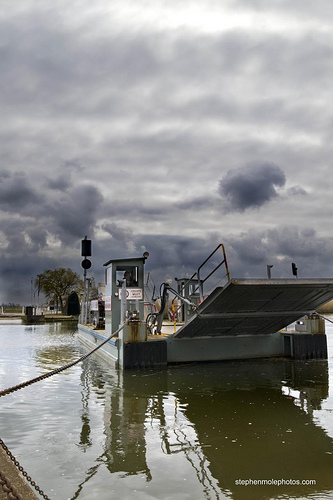|
|
|
|
Reedham
|
Reedham lies 12 miles south-east
of Norwich. The village is
built on a spur of higher ground overlooking a vast area
of marshland created by the confluence of the
River Yare and the
River Waveney.
The railway line from Norwich to
Yarmouth splits at
Reedham - with one track heading north-east through the
marshes to Breydon and the other passing south-east over
the swing bridge towards Lowestoft in Suffolk.

River Yare at Reedham
There is a marvellous poem called Reedham Marshes
by the poet Edwin Brock which recounts his experiences
of being stranded aboard a cruiser on the river here:
|
They say the
water's salt here
as though the North Sea's fingers
are at our belly, tickling us like trout.
Dozy from blue and bottle-green,
we wallow in each passing wash
like a long drunk on a hot Saturday.
The reeds sigh and part as we enter them,
then zip us up behind like some
silk Sargasso. It is an old fantasy.
Sick from a seized engine, we sit
in this sanctuary of seabirds where
at night the crocodiles slip from holes
in their reed bed to jostle us
like hissing logs; and we confuse
the red rising moon with its setting sun.
Now no longer water-borne we drift
on this night mist which dreams us:
there are sharp cries, quiet splashes
and the voices of fishermen in an old pub
where a hand pours a White Shield Worthington
as clear as a bell and without a hint of mud. |
Reedham is also famous for its chain ferry which, for
many years, has carried motorists across the river.

Reedham Ferry (Photograph © Stephen
Mole) In Crow Country the nature writer Mark Cocker describes the ferry and
how it's played a significant part in Norfolk's
transport network for centuries:
|
| 'Halfway between
the two bridges in Norwich and Yarmouth is Reedham where
there's a small private ferry, which maintains a long
venerable tradition and reflects the historical answer
to the Yare's hindrance. In previous centuries there was
far more contact between the two sides. On either bank
the recurrence of the 'ferry' place names - Ferry Road,
Ferry Lane, Ferry Farm and various Ferry inns - speaks
of a community that looked to the water as a means of
communication. Yet to cross from side to side was one
thing; to leave the valley itself was another matter
entirely.' |
The Norwich School
artist Joseph Stannard (1797-1830), who had a particular
affinity with the River Yare, painted both Reedham and
Buckenham Ferrry.In The Rings of Saturn W.G. Sebald
describes the train journey from Norwich to Lowestoft
which passes
through Reedham. He was heading to Lowestoft to begin
the walk that would provide the structure for this
innovative and unusual work of non-fiction.
|
| 'Through Brundall,
Buckenham and Cantley, where, at the end of a straight
roadway, a sugar-beet refinery with a belching
smokestack sits in a green field like a steamer at a
wharf, the line follows the River Yare, till at Reedham
it crosses the water and, in a wide curve, enters the
vast flatland that stretches southeast down to the sea.
Save for the odd solitary cottage there is nothing to be
seen but the grass and the rippling reeds, one or two
sunken willows, and some ruined conical brick buildings,
like relics of an extinct civilisation.' |
Reedham also has another interesting literary link.
During the 15th Century, when the the church tower of
St. John the Baptist was being built, Margaret Paston
gave 8s and 4d towards its cost. Margaret, who is buried
at Mautby church, wrote many of
the Paston Letters - which give us a fascinating insight
into English social history.
Links:
More photographs of Reedham
|
|
|
|

